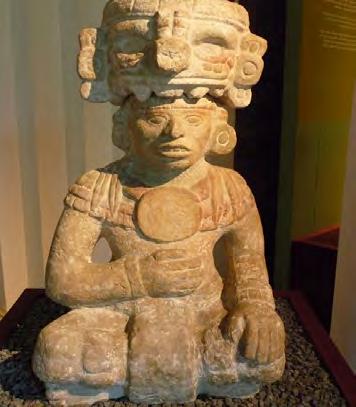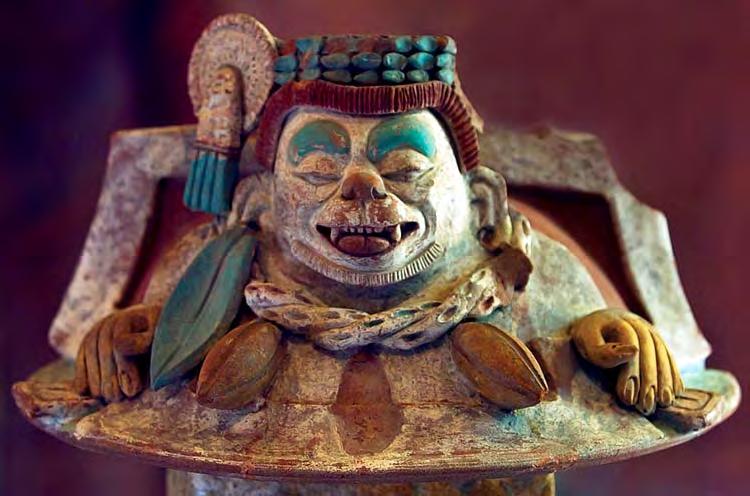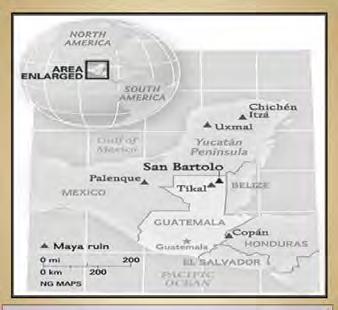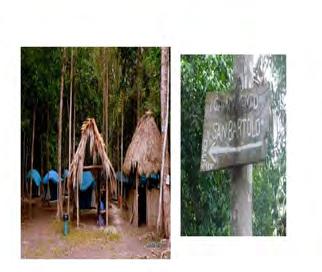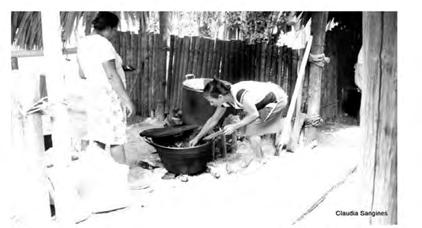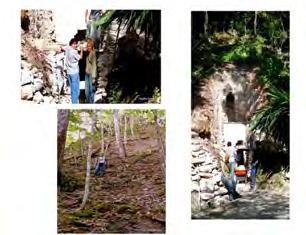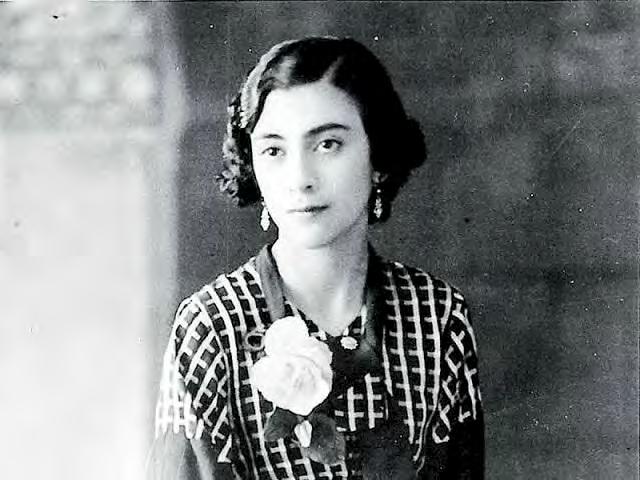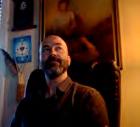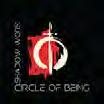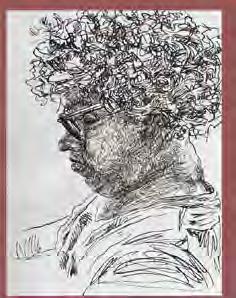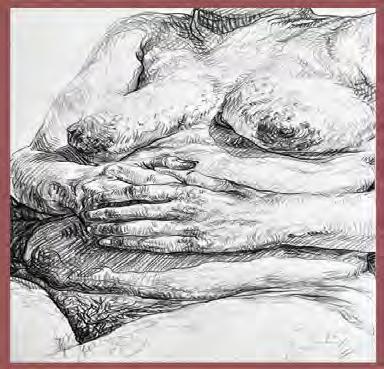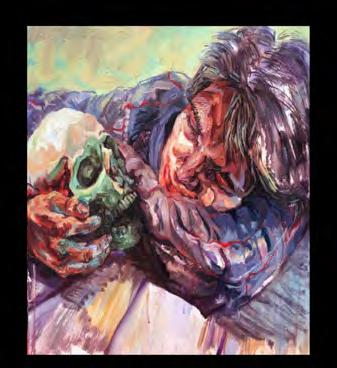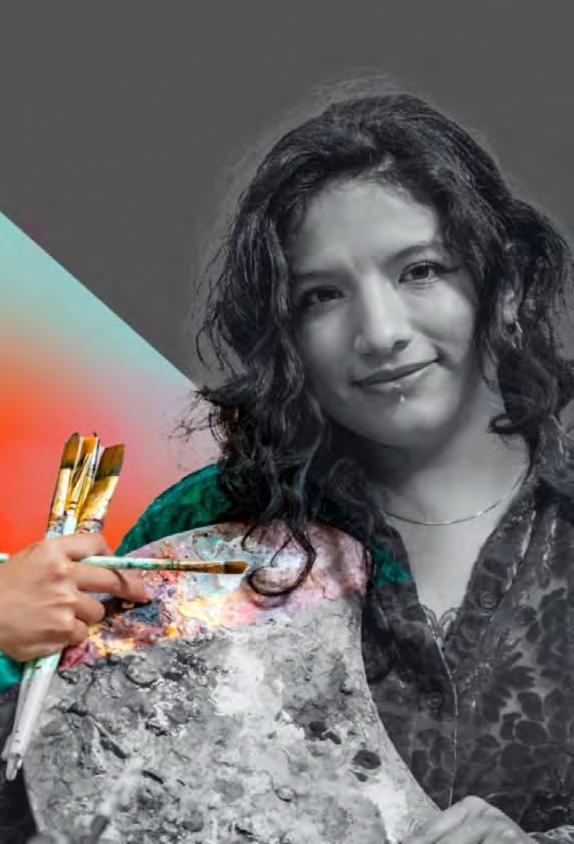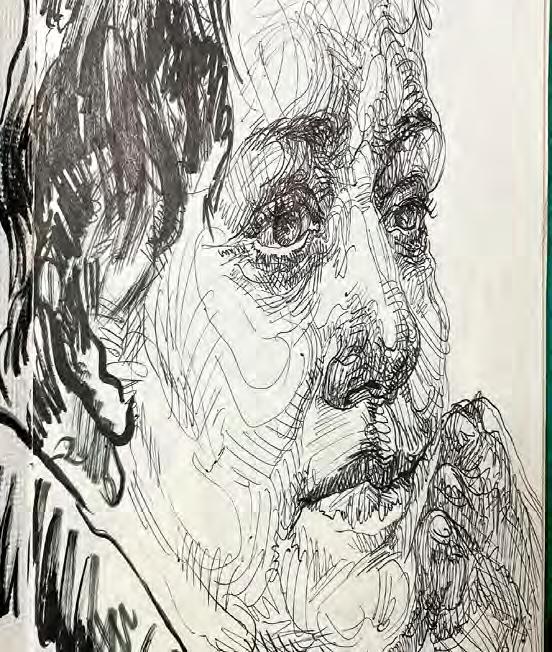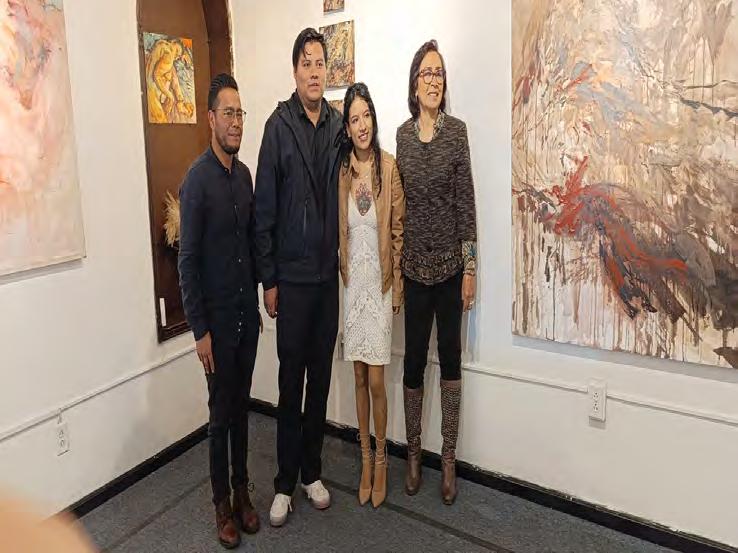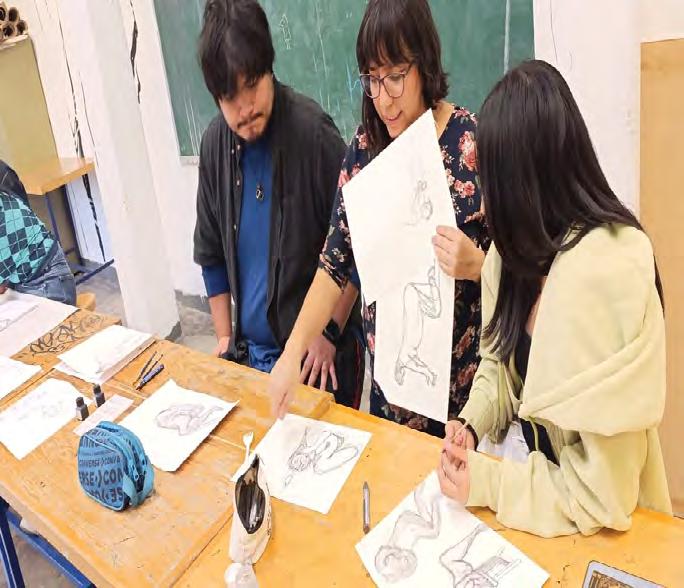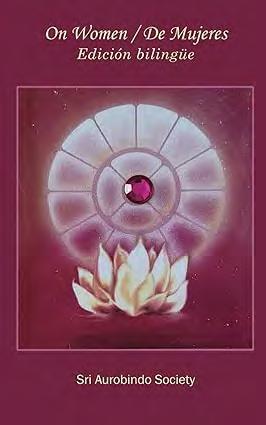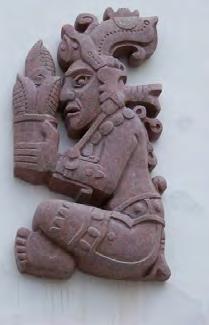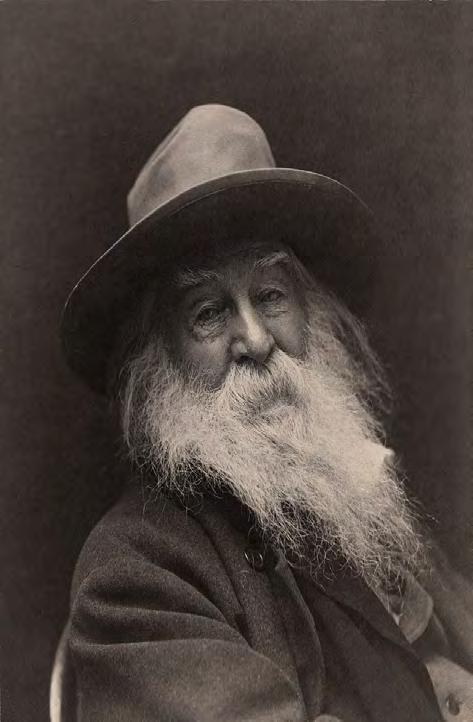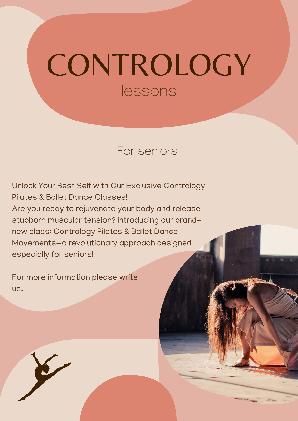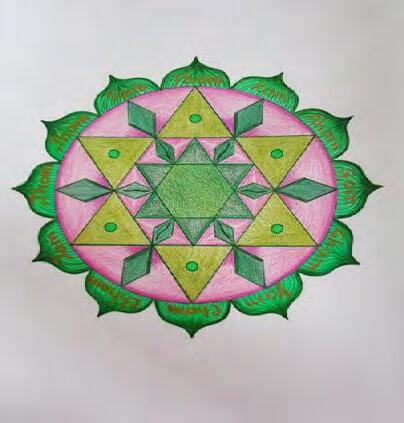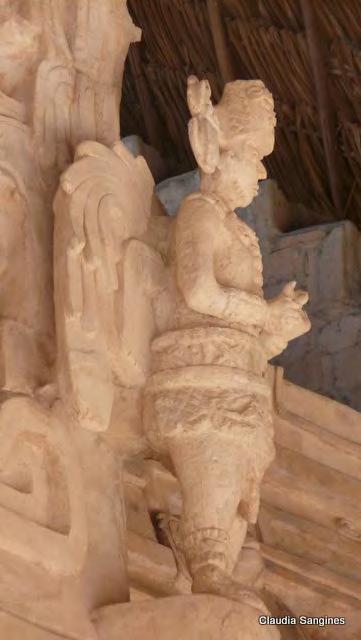Collective Artistic Creation of Art “Mayan
Preclassic”
Ma. Claudia Sanginés Sayavedra1
“The objective element will allow the work today say in the future I am, instead of I was.”
V. Kandinsky.
The study of mural painting represents in itself a complex search and recognition of a specific way of painting that links a group of artists. That is why it demands an approach that includes the review of the different theories, as well as the possibility of considering new approaches to the problem. In the following presentation the objective is to demonstrate, through a typology of features created by Luis T. Sanz for a case study in the Madrid codex, which the painting of North wall of San Bartolo, was intervened by several artists.
The following document is divided into two parts. Archaeological site location and collective artistic creation of the San Bartolo mural painting.
I. Location and Archaeological Site of San Bartolo
In the Petén jungle between the archaeological sites of Tikal and Uaxactún (figure 1) finds the archaeological zone of San Bartolo, rediscovered in 2001 by the American William A. Saturno, who currently directs the San Bartolo project together with the University of San Carlos, Guatemala.
Figure 1. Mayan area and San Bartolo Archaeological site.
1 Bachelor in History and Master in Art History (UNAM).
In the area of the San Bartolo site, the following architectural groups stand out: To the North the Ventanas Group, to the West the Jabalí and Tigrillo Group, to the East the Pinturas.
Towards the south you can see the opening of the complex with an elevated road that emerges from the main square, and finally there is the Las Plumas mound (Figure 2).
Due to the characteristics of their structures, Windows and Paintings were considered the most important groupings (figure 3). The second structure is associated with the pyramid of the same name (figure 4 a and 4 b).
It has been discovered that the pyramid where the northern mural is:
It has 7 construction phases and the last one that we do not know if it was a remodeling or new architectural phase. The first structure is called Ixkik (sub-7), the second Ixmucane (sub 6), the third Ixbalanque (sub 5) … thesixth was named Ixim and Yaxché (sub-2) and the seventh where the fourth was withthe murals (sub 1 A) and the last stage was called Paintings.
And in the eighth we only say that we found it but we don’t know if it was a remodeling or another stage (figure 5 a).
It is known that Ixkik belonged to the middle Preclassic period and the last phase to the period Late Preclassic.
In 2004 the project made significant progress in the excavations, discovering that in that building there were also friezes on the West, East and South side
(figure 6 and 6b). Likewise, they found different cartridges with writing that have been studied by David Stuart (figure 7a, 7b and 7c). And with the excavations from 2005 to 2009 they found mural painting in sub-B, and fragments of mural painting older than those in sub A, that is, dating back to 400 BC. C.
The mural that I will work on in this presentation is located in a room called sub 1 A (which belongs to the sixth or seventh stage of construction), which measures 4.8 x 9 m2 in plant and is oriented from North to South. This construction rests on a small platform, with a step that gives access to the enclosure with three front doors and two sides. The frieze was only 1.40 m high, it had continuity on the walls from the west and east (figure 6b).
Figure 2. San Bartolo camp in Guatemala
Figure 4b. Photos structure Ventanas
Figure 4 y 4b. Photos structure Ventanas
Figure 3 and 4. Women helping in the camp of San Bartolo. Pyramid Ventanas
Painter and PhD student at Yale, Heather Hurst, conducted a study on the painters in the northern mural of San Bartolo, based on the classification study by the Italian Giovanni Morelli. With this, the researcher maintains that the paintings of the North and West murals identify the presence of two or three painters.
In this presentation the hypothesis of the artistic collective will be developed but only for the case of the north mural.1
In the painting of the north frieze there are fourteen figures that can be classified as Anthropomorphic, most of them outlined in black, five characters are painted standing and the rest were represented in other positions, all individuals.
They are characterized in profile. In addition, you can find phytomorphic figures and zoomorphs that were also outlined in black.
To facilitate the description and location of the characters represented there, I divided the mural in two parts formed as follows in the first part seeing the mural from right to left are all the characters closest to one human representation and in the second part the individuals who are anthropomorphic, but its gender is not clear.
The objective was to select certain elements that help recognize the difference and similarity in stroke, composition, color and position in the painting. In this way, I made a classification of elements following the method used by Luis T. Sanz Castro: typology of diagnostic features (catalog the motifs that have a repetition in a linked image and this will help correct identification and visual reading).
I chose an integrated corpus of repetitive shapes throughout the painting. For this select a first extensive corpus of anthropomorphic figures, all the
1 Look the ilustrations in https://www.flickr.com/photos/doncoyote/3014830075/in/ album-72157608783430242
representations of flora and fauna. In the second segmentation I chose three elements significant and repetitive in the figures: hands, eyes and feet.
The corpus was as follows:
• Hands: I divided them into simple hands (MS); and complex hands that hold (MCS); complex hands free (MCL); complex hands point up (MCA)
• Feet: Separate them into simple feet (PS); double feet (PD); and complex feet (PC)
• Eyes: I divided them into simple eyes (OS) and compound eyes (OC)
Hands. I found that there were two types of hands: simple and complex. The I found the first ones only in the second part of the mural while the complex ones in the entire representation of the northern painting.
Characteristics simple hands (MS). They are those that were only representedwith a thumb and the silhouette of the hand outlined, without fingers, as if they weretongs or gloves. Almost all closed with some exceptions that had asemi-rectangular, rectangular and open shape. They are red and in most of them have a closed and rounded posture, they have a space between thered paint and the line that surrounds them.
The stripe is thin and black. In total I found 10 simple hands drawn in profile, without showing the palm (figure 12a); nine of they, who correspond to the small characters, tend to join their thumb with the rest of the hand. They do not hold any object and are complete. Only in a case, I found her represented larger and holding an object, more rigid than the others, (character one of the second part.
Characteristics complex hands (MC). I found these types of hands both in the first as in the second part of the mural. There are a total of 13 complex hands whose constant is that the fingers are outlined in all of them (figure 13a). Within a second division was made: complex hands pointing up (MCA), and complex hands holding (MCS), and complex hands free (MCL).
MCA’s are those that, as their name indicates, have at least one finger that points upward, they are always represented in profile and with the hand semi-closed index finger indicates the action. I found two double hands and one single.
I found the doubles in two kneeling women in the first part and the single one in the character one of the second part.
On the other hand, MCS have the main characteristic of carrying or holding a object. In total I counted eight hands of this type, one in yellow and the rest in red. They are represented in profile with the thumb outward and the fingers facing out. the right or left end depending on the case. Two are double and hold a object in the same position and shape (Check figure online thesis Claudia Sangines).
Finally, the MCL, their characteristic is that they are loose expressing movement, are present in an individual in the first part. They are two yellow hands, with the fingers joined, but separated into their phalanges that end in a point.
Feet. In this case it is an element that shows the difference between the stroke and the form. In the mural I found 21 feet represented in different colors, positions and shapes that I divided into simple, complex and double feet.
Characteristics of Simple Feet (PS). They are those that were only represented by their silhouette, and do not have any dividing line that defines the fingers, in total they found fourteen simple feet. Most are red and are positioned horizontal. Some of these feet have a pigment less space between the color and the line, a characteristic that is observed especially in those of red color. The shape predominant PS is triangular, with the arch well defined in some cases.
Double feet (PD) features. They are those in which one of the feet does not represents completely since it appears behind the other, only the silhouette is seen, which goes next to the other foot in a vertical position. There are five representations of this type of standing on the mural two yellow and three red.
Characteristics of Complex Feet (PC). There are only a couple, they were found in the first part of the mural, their toes are marked by a black line. Are the largest feet in the entire painting, its shape is more rounded. These tend to be very arched, their posture is the same as most simple feet, they denote stability since they are horizontal, resting mainly on the sole of the foot, and seem two right feet.
C. Eyes. In the work the eyes were made in different ways since in some find that the artist tried to give them expression through the eyebrow or the narrowing of the pupil. In total I found 14 eyes, of which only some they have similarities. I divided them into simple and compound eyes.
Characteristics of simple eyes (OS). In total I counted six simple eyes that I found them represented in the first and second parts of the mural. These eyes only they present the iris and an eyelid that may or may not be outlined in black, depending of the character. The line alternates from very thick to subtle. The eyes vary in size and shape. Example: The iris can be as small as a dot to a large circle and well defined; the shape is sometimes more angular ending in points and other times It is more rounded.
Characteristics of compound eyes (OC). They are present in all the mural work, They are made up of eyelids, irises and eyebrows, in different sizes and shapes. In total they are seven of which only one (OC6) is completely different in shape, size and expression, for the same reason it has not been counted for comparison and analysis.
Results and Conclusions
With the typology of diagnostic traits, I found new ways to organize the motifs he had selected: feet, eyes and hands. To observe the differences, I enlarged the photos in Photoshop, so I could create a general mapping of the motifs worked by dividing them into a box by color, line, size and shape (Box 1a, 1 b and 1 c), which helped me observe the differences in the painters’ lines.
In the elements studied I found that some did not present a black profile of outline, most were outlined by a thin black line separated from the color for a space without pigment; 17 hands and 14 feet were represented in one color red with
Photo: Detail sculture Mayan Classic period.
Feet of a classic Mayan sculpture that already present a more complex decoration in the attire.
Claudia Sangines.
Photo:
the exception of a pair of double hands and feet and a pair of hands and feet complexes in yellow color; and a pair of simple feet without pigment, In those cases no there was separation between the contour line and the pigment.
My attention was drawn to the two complex hands holding MCS1 and MCS2 that they belong to individual 1 from the first part of the mural, and have no similarity in the stroke, since the first is thin and elongated, while the second has a wider, the fingers are rounded, and the thumb, unlike the other, has an unusual posture. In this character, observe that there is no proportion between the hands, the body and the feet.
Since the lines of the feet are more delicate and they are small, the body also has a more stylized outline. In the feet I saw that the left one is larger than the right one.
On the other hand, most of the characterized feet tend to show the arch, for therefore, I deduced that they drew two right feet on each character. The complex hands (MCL), also appear to be two left ones, due to the posture shown by the fingers since they outline the extreme parts of the hand and not the internal part.
The feet in general showed a very similar shape, a thin line and some size differences.
When analyzing the eyes, I found that, if seen in the entirety of the painting, they create a relationship between the characters, and therefore help the scenes have action. But when studying the line in this element I realized that none of them have the same stroke, there are similarities in composition, that is, the representation of the eye with all its elements: pupil, eyelid and eyebrow; or in others the eye only with pupil and eyelid.
The simple eyes have similarity in the shape of an ovule and in the small pupil, the only different is 0S5 which has a larger pupil which could have been completely intentional to create an effect on the character’s gaze (figure 24 a, and 24 b).
Unlike simple eyes, complex eyes showed different shapes and in four a similarity is seen in the pupil painted in the center of the eye and small, the OC6, OC1, OC4 have a pupil on the other side of the eye or larger.
What did the typology of diagnostic features in the analysis of the hands, feet and eyes of the northern mural of San Bartolo? With the typology you can make a particular analysis of the details of a trait repetitive in painting, but the results are very ambiguous since there is no way to ensure the number of artists who participated in the creation of the mural and the specialty of artists.
I think it takes more time and more information about the technique to be able to confirm the number of artists and the specialty of each of them. But, on the other on the other hand, the case study of the northern mural with the method of Luis T. Sanz helped me to confirm Heather Hurst’s hypothesis of the mural collective. Since I could observe the difference in stroke, in the proportion, size and shape of the hands, eyes and feet.
It is important to clarify that in the end you notice that my choice of elements was not very accurate since the artist tends to change the eyes to give it a certain expression and movement to the figure that it has to characterize, therefore it cannot be an element to observe the difference between artists, since one can only execute a great difference in that element to show the individuality of the character.
The hands and feet, unlike the eyes, were extremely useful as elements to study the different stylistic expressions of the artists. Since in these features observe a firm line and a looser one, a stronger line and a stronger line and a thinner line. Also, in the feet there is a rigidity of representation in which observe small changes in composition, which is an indicator of a change of painter
In conclusion, we can now know that certain study methods can help find the specifications of certain elements in the works as indicated in the case of the northern mural of San Bartolo.
The artistic collective is something that we researchers consider a fact, but the form and method of studying changes depending on the object to be analyzed and of course the preferences of the researcher.
The pictorial work of substructure 1 of San Bartolo was created by a collective artistic that apparently had a pictorial discourse to follow. I guess the differences in the line can be seen very little because San Bartolo already had a language collective pictorial, that is, a tradition that helped form an almost similar form but not identical in their forms of representation.
The study of the artist community continues to be a topic that will be hypothetical since it we can approach with little precision due to the lack of a method and materials that help us know more about the work and the situation.
And as André Maurois said “Every artist is so multiple that the critic cannot help but stop finding in him what he seeks resolutely and a priori.” So, I consider that every research work is an experiment to improve the method, the language, investigate new theories and formulate ideas that bring us closer to that subjective
Note all the drawings of San Bartolo can be seen in the books published by
The San Bartolo Project, in books of articles by the San Bartolo Project.
Claudia Sangines’ master’s thesis has all the details of the drawings and is located in the UNAM library.
Another website to see the mural paintings
https://www.flickr.com/photos/doncoyote/3014830075/in/ album-72157608783430242
Bibliography
Beltrán, Boris, “Excavations of the Third constructive stage of the architectural complex the Paintings (Paintings sub 6)”, in William A. Saturno and Mónica Urquizú, Archaeological Project San Bartolo regional. Annual Report no. 7, Seventh season, Guatemala, William A. Saturno and Mónica Urquizú, Report delivered to the Institute of Anthropology and History of Guatemala, 2008, p.42
Giunzburg, Carlo, “Clues, Morelli, Freud and Sherlock Homes”, The Sing of Three: Dupin, Holmes, Pierce, Ed. Umberto Eco and Thomas SEbeonk, Bloomingten, Indiana University Press, 1988, pp. 81-118.
Lacadena, Alfonso, Formal evolution of Mayan scriptures: implications historical and cultural. Doctoral thesis, Department of American History II, Faculty of Geography and History, Complutense University of Madrid, 1995.
Lopez Austin, Alfredo, The myths of the Tlacuache, UNAM, Institute of Anthropological Research, 1996.
Magaloni, Diana, “Materials and technique of Mayan mural painting”, in Leticia Staines, coord., Pre-Hispanic mural painting in Mexico. Mayan Area. Studies, Mexico, Volume III, UNAM, IIE, 2001, pp. 155-198.
____________, “Mural painting techniques in Mesoamerica”, in Archeology Mexicana, Vol. III-Num. 16, Nov-Dec., 1995.
Morelli, Giovanni, Italiana Pointers: Criticizing Studies of Dyeing Works, Edit. C. J. Foluces, London, 1893, digitized by Harvard University on June 26, 2008.
Román, Edwin et al., “Ceremonial structures of the Preclassic period: Ixim, an example of this”, in William A. Saturno and Mónica Urquizú, San Bartolo Regional Archaeological Project.
Annual Report no. 7, Seventh season, Guatemala, William A. Saturno and Mónica Urquizú, Report delivered to the Institute of Anthropology and History of Guatemala, 2008, chap. III, p. 32-41.
Sanginés Sayavedra, Claudia, Pre-Hispanic mural painting in the late Preclassic period. The case of the northern mural of San Bartolo, Petén, Guatemala, Mexico, Claudia Sanginés, Thesis to obtain the degree of master in Art History, Faculty of Philosophy and Letters- UNAM, directed by Dr. Dúrdica Ségota Toma, 2010.
Sanz Castro, Luis T., “Los escribas del Códice de Madrid: Metodología y análisis pre-iconográfico”, en Revista Española de Antropología Americana, España, no. 30, 2000, pp. 87-103.
Saturno, William et al, “New architectural and pictorial finds in the Pyramid of Las Paintings, San Bartolo, Petén”, In XIX Archaeological Research Symposium in Guatemala, 2005 (edited by J.P. Laporta, B. Arroyo and H. Mejía), pp. 627636. National Museum of Archeology and Ethnology, Guatemala (Digital version), 2006.
______________, “The murals of San Bartolo, El Petén Guatemala, Part 1. The muralof the North”, in Enciente América no. 7, USA, Center cor Enciente American Studies, Barnardsville, February, 2005, (Spanish Edition).
Savkic, Sanja, Color in the Dresden Codex (according to information from written sources and linguistics), Master's Thesis in Mesoamerican Studies, Mexico, UNAM, 2007.
Shapiro, Meyer, “Style”, in Anthropology Today, Chicago, The University of Chicago Press, 1953, pp., 287-312.
Ségota Toma, Dúrdica, “The task of the historian of pre-Hispanic art. The meanings of images”, in Beatriz de la Fuente (coord.), Walls that speak. Essays on preHispanic mural painting in Mexico, Mexico, El Colegio Nacional, 2004, pp. 31-41.
_____________, Plastic values in Mexica art, Mexico, IIE-UNAM, 1995.
Torrelba, Daniel and Marco Tulio Sandoval, “Report on the structural stability of the pyramid the paintings” in William A. Saturno and Mónica Urquizú, San Bartolo regional archaeological project. Annual Report, Third Season, 2004, chap. 17.
Photo: Atitlan, Guatemala. Claudia Sanginés
What is more feeble than a god? It wails, starving,
Smelling the blood of a victim, Eats sacrifices and hunts for the entrails Of the created, in order to sink its hundred Rapacious teeth into them. (A god. Or certain men who have a destiny).
Each day dawns and the world is once again devoured.
Rosario Castellanos
Unveiling
the Depths: Non-Duality
Psychotherapist Mihai Algiu
We recently had the privilege of speaking with Mihai Algiu, a nonduality psychotherapist practicing in California. Mihai’s journey, from growing up in communist Romania to becoming a healer of the mind and heart, is a testament to the power of self-exploration and the pursuit of inner peace. His unique approach combines somatic therapy, awareness practices, and the Kiloby Inquiries, offering a profound path to healing and self-discovery.
Mihai’s interest in spirituality began in his teenage years, a quest to understand the deeper questions of life: “Who am I really? Why are we here?” This pursuit led him through various teachings and practices, ultimately shaping his approach to psychotherapy. He emphasizes the importance of feeling and experiencing emotions within the body, rather than simply talking about them. “What happened is in our body now,” he explains, highlighting the connection between past experiences and present sensations. His path to becoming a therapist wasn’t a straightforward one. Initially, he explored various spiritual traditions, seeking self-knowledge and inner harmony. He later discovered Hakomi therapy, a somatic approach that resonated deeply with his own journey. This, combined with his spiritual background and the Kiloby Inquiries, forms the foundation of his practice.
Mihai’s work isn’t driven by a desire to change the world, but rather by a deep connection to the process of inner exploration, both his own and that
of his clients. He finds fulfillment in witnessing others’ growth and transformation, and the work itself fuels his own journey of self-discovery. “It’s the most fun job for me,” he shares.
Beyond his professional life, Mihai finds balance through various hobbies. He was a serious tennis player in his youth, which instilled in him the value of consistent practice. He also enjoys archery, rock climbing, nature, and hot springs.
Our conversation touched on a wide range of topics, from his favorite movies (including “Braveheart,” “Fight Club,” and “The Matrix”) and music (Bach, classical composers, and the band Tool) to the books that have influenced his life (works by Ouspensky, Gurdjieff, Eckhart Tolle, and Ramana Maharshi).
Mihai shared a powerful insight about spiritual experiences: “My understanding about those states is that they come and go.” He emphasizes the importance of the revelations and understandings that linger after these experiences, rather than the fleeting states themselves. He also spoke candidly about his experience with a powerful psychedelic substance, emphasizing the importance of caution and preparation.
He believes that spiritual life is not separate from everyday life. “Every stress, every friction, every difficulty, every reaction is an opportunity for work,” he explains. As one matures on the spiritual path, the distinction between practice and life dissolves.
Regarding his therapeutic practice, Mihai clarified that he does not use drugs with his patients. He works individually with clients, utilizing a variety of tools depending on their specific needs. He also leads group sessions, which he finds particularly rewarding.
Mihai doesn’t feel drained by his work with clients. He maintains his own well-being through activities like watching movies, archery, listening to music, and spending time in nature.
He emphasizes the importance of self-regulation practices like Qigong, Tai Chi, and meditation.
He emphasizing the importance of addressing the root causes rather than seeking temporary relief.
Mihai acknowledged that his therapy approach is not suitable for everyone. He adapts his methods to meet the individual needs of each client, recognizing that some may require a different approach.
When asked to describe his work in five words, he offered:
“I do like from the Fourth Way Remember yourself always and everywhere, I know is challenging and one need to know more than that. I do like this from one of my teachers saying: Meditate, Investigate, Celebrate Meditate, investigate, celebrate. Which are different stages of getting more conscious, first tuning into the meditation as being a portal to our true nature, meditation is ultimately not a practice is what we are, now if there is some problem, some suffering, some anxiety, inner conflict, then I need to search, going to see what’s up in my body, investigate or process, then when that is clear and things are good, then enjoy life, enjoy life. And if there is again another problem MEDITATE, INVESTIGATE, CELEBRATE.”
This encapsulates his approach to self-discovery and the integration of spiritual practice into everyday life.
therapy sessions. His website provides more information about the different types of therapy he offers, including Hakomi, psychosomatic spiritual counseling, clinician/practitioner training, and a “Journey Within” immersion.
If you’re interested in learning more about Mihai’s work, you can visit his website: https://circleofbeingshadowwork.com/ and his YouTube channel at https://youtu.be/jjTWLVv5bxkm.
We are grateful to Mihai for sharing his insights and experiences with us.
His work offers a valuable contribution to the field of healing and self-discovery
Mihai offers individual and group
DISCOVER
A YOUNG PAINTER
On this occasion, Alasart reached out to a new young painter, who, at just 20 years old, already has a portfolio of paintings to offer the public with different techniques and styles.1 I was amazed by her piece of “Pietà,” which has a new perspective and brilliance embedded in it. It conveys the peace of the mother, though with pain from the death of her son’s body, the Virgin holds the faith in the eternity of the spirit. A contemporary way of creating blackand-white painting with deep tones and straight strokes. The light in the painting radiates youth and, above all, hope.
In the end, I will leave it to the readers to interpret the painting and the work of our new guest, Itzel Beltrán Orozco, who discovered that the visual arts have been a part of her life since she was very young, but began creating in 2013 and studying formally in 2016. It is important to remember that the arts are incredibly significant for our being and soul, as they are a means of expression.
1 This interview was from 2020.

A part of our divinity. They are essential for developing our sensitivity and senses. They educate us; in this case, painting helps the artist to see, and the expert interprets, expresses, and gives the world something new to signify life from a new perspective. Along their journey, they explore different techniques, styles, and artistic movements until they find one that truly suits them and their environment. Art productions typically reflect both their inner world and the outer world. They thus safeguard a history of the human psyche. Our invited painter, Itzel Beltrán Orozco, kindly agreed to answer an interview to spread her work on Alasart. We hope that the readers of the blog and others will become sensitized to her work and also help, in whatever way possible, to ensure that the arts continue to be part of education in Mexico and the world. And that artists remain a fundamental part of our daily lives, as without them, life would not evolve. In the interview, the painter shares her website and contact details in case anyone wants to help by purchasing her work.
Alasart: Tell us a little about your biography and if you have a website.
Itzel:
I was born in Mexico City in 2000, where I currently reside. I began my informal artistic education in 2013, and in 2016, I studied painting, graphic art, and drawing at the Technical School of Plastic Arts in Naucalpan. In 2017, I started studying drawing and painting at the San Carlos Academy, and in June of that same year, I took a Contemporary Painting Seminar with Master Nizaac Vallejo, with whom I am still cultivating my education to this day. In 2018, I entered the Faculty of Arts and Design at UNAM, where I am currently in my 5th semester of a Bachelor’s degree in Visual Arts.
Alasart: What type of art do you create?
Itzel:
Primarily, I develop my work in the genres of portraiture and nudes.
Alasart: Since when you have been making art?
Itzel: Since 2019.
Alasart: Is there any artist you would like to share with us who has inspired your journey?
Itzel:
Lucian Freud has been my main mentor in my creative process. His approach to the body, the concept of flesh, and the idea of fatal existence sparked an intimate reflection in me and much study, both in painting and drawing, in my work as a painter. Lucian Freud does not just paint the body; he generates it as a painting. The pictorial material that takes shape on his canvas is the vivid relationship between the painter and his subject. In this case, his subject presents the human being without measure, without shame, and that carefree vision still has much to tell us.
Itzel
Corporeal
Alasart: Please share 5 pieces of your artwork with descriptions. If it’s music, provide an audio description in writing.
Itzel:
One piece that marked a turning point in my production is this one. From this corporeality of drawing, the line, as a formal element, generates fragility and study.


A first approach to the body as a layering of sensations. It is a portrait of my brother, which made me understand the importance of a relationship with the subject in order to generate meaning. In this case, we both come from the same womb. This piece was created in two very distinct moments, yet in a very immediate way. Drawing takes vital relevance in this piece due to the construction of form, light, and color. A symbolic value is death, which is not shown as an invasive and voracious presence. In fact, it is a close relationship with the body itself. This piece was produced in a cathartic moment, based on human relationships, intimate bonds, and close experiences. This empathy that can be generated through painting is, in fact, a way to bring back a soul that deserves to transcend. Its pain and despair fall, surrendered before a light that does not arrive, but suffocates nonetheless.
Perish to trepitate Itzel Beltran
Acrylic on panel
Disrupting Death
Alasart: How has the 2020 pandemic affected your work?
Itzel:
As a student, the university spaces allow me to continue developing my knowledge and receive feedback. In this inability to continue meeting, this creative and collective space has been fractured. My colleagues always contribute a lot to what I do and to my growth. Likewise, my workspace, such as the workshops at the Faculty and the private studio where I constantly generate works, are closed, and I have had to adapt my home into a space with the necessary conditions to work properly with certain formats and techniques. Exhibitions have been postponed, and other projects have been affected by this unprecedented situation.


Another aspect that I consider important to address is mental health and the “inhabited” space from confinement. As many of us may be suffering around this extraordinary time, we are subjecting ourselves to the containment of many emotions and experiences. This has given my work a more introspective development, and also a great amount of time to mature and solidify ideas.
Alasart: Do you already have a planned future as an artist?
Itzel:
I have some paths I will follow, such as continuing to work and produce the subjects of my interest, formalizing my work professionally, and hoping that the work receives representation and recognition. However, at this moment in my life, I don’t frame the future as imposed goals. My perseverance is more focused on the process, which is gradually taking shape and developing, and with that, I will continue working. In reality, the only thing that interests me is to keep creating.
Alasart: What book has inspired your life?
Itzel:
Although I don’t read consistently, there are books that have remained present for me: The Young Orozco: Love Letters to a Girl by Adriana Malvido, Man’s Search for Meaning by Viktor Frankl, and Lessons in Drawing by Juan José Gómez Molina.
Alasart: Favorite music?
Itzel:
Disco, nu metal, rock in many subgenres, and pop.
Share with us the techniques you use in your work, instruments, and a day in your life as an artist.
Itzel: Every day is different depending on the moment of the process I’m going through.
I dedicate time first to prepare supports depending on the materials. I prime boards or canvases if I need to, mainly when I’m going to work with oil. I work with techniques such as oil, acrylic, ink, watercolor, pastels, charcoal, wax markers, pencil, etc. Mostly, I only use brushes for application, except, of course, for charcoal and markers. I also work with printmaking.
I prime boards or canvases if I need to, mainly when I’m going to work with oil. I work with techniques such as oil, acrylic, ink, watercolor, pastels, charcoal, wax markers, pencil, etc. Mostly, I only use brushes for their application, except, of course, for charcoal and markers. I also work with printmaking techniques such as woodcut and variations of intaglio printing, including etching, aquatint, etc.
Alasart: Share with us the techniques you use in your work, instruments, and a day in your life as an artist.
Itzel: Every day is different depending on the moment of the process I’m going through. I dedicate time first to prepare supports depending on the materials. I prime boards or canvases if I need to, mainly when I’m going to work with oil. I work with techniques such as oil, acrylic, ink, watercolor, pastels, charcoal, wax markers, pencil, etc. Mostly, I only use brushes for application, except, of course, for charcoal and markers. I also work with printmaking.
I prime boards or canvases if I need to, mainly when I’m going to work with oil. I work with techniques such as oil, acrylic, ink, watercolor, pastels, charcoal, wax markers, pencil, etc. Mostly, I only use brushes for their application, except, of course, for charcoal and markers. I also work with printmaking techniques such as woodcut and variations of intaglio printing, including etching, aquatint, etc.
Follow her in social media
X
@ItzelBeltrn
Facebook
https://www.facebook.com/itzelbeltrn/?locale=es_LA
Video in spanish
https://www.facebook.com/watch/?v=527905654858608
Youtube https://www.youtube.com/@ItzelBeltran-zi4tq
